- HubPages»
- Pets and Animals»
- Cats & Cat Breeds»
- Cat Behavior
Why Do Cats Purr and Meow?
Do you often lie awake at night while your cat is yowling in the corridor and wonder what your pet is trying to tell you? Have you ever stopped to consider what your feline friend is trying to communicate when they purr at you? Cats are animals that are notoriously hard to read, but once you’ve wised up a little you may just come to realise that your pet isn’t quite aloof as he once seemed to be. Your precious Mittens has been talking to you all along; you’ve just never understood the language he was using. Listed below are some common cat vocalisations and what they mean.
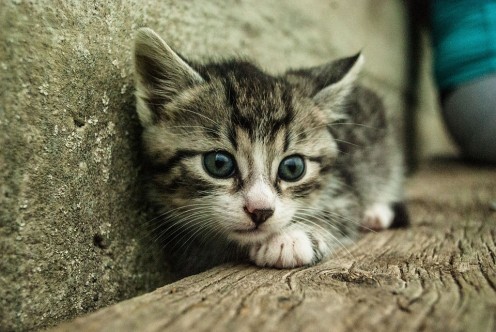
Purring
A purr most often indicates contentment and signals a wish for physical affection: "pat me, human! What else are you good for?" In some cases cats will also purr in anticipation; "Yay! I’m about to be fed!" Studies have also shown that purring triggers the release of endorphins in feline brains, and thus it follows that cats also purr as a means of self-comfort, "I’m making this noise because it makes me feel good."
It’s been scientifically proven that the frequency of purrs helps increase bone density, in both the cat and human companions. Thank your pet the next time they cuddle up to you and start purring; they’re making your bones stronger!
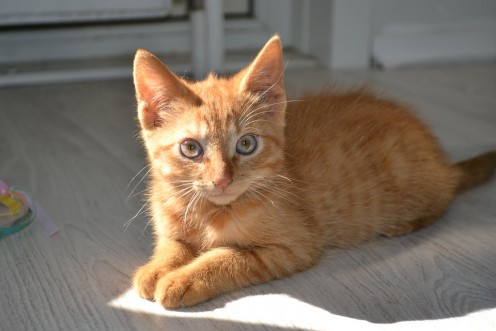
Meowing
The most basic meaning of the meow is "give me attention!" The meow can be compared to a baby’s cry, because just as a baby uses different kinds of cries to convey different demands, so too do cats. As you get to know your furry friend you’ll likely become more attuned to the difference between their "I want food!" type of meow and their "let me out!" meow, probably even subconsciously. Generally, the lower the meow is, the more anxious the cat is and the more serious their demand will be ("you forgot to feed me yesterday and I’m starving, human!"), while a higher meow can be used as a friendly greeting; "welcome back from work!"
Some cat breeds tend to meow more than others do. Siamese and Oriental cats are known to be chatty, while the British shorthair and American breeds are quieter.
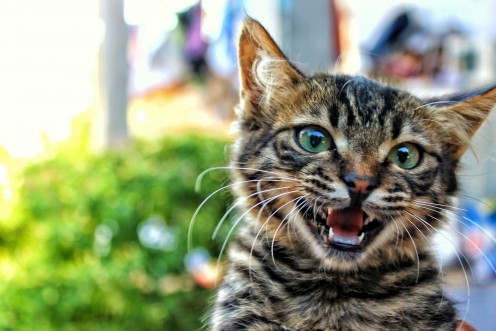
Hissing
The meaning of a hiss is usually fairly self evident: "Leave me alone!" Hisses communicate a mixture of fear, anger and annoyance. Your cat likely feels threatened and is warning you and anyone else in the area that they’re about to start biting and scratching; "you’d better move out of my way, or else!"
Many experts have theorised that cats hiss in an attempt to imitate snakes, to warn predator that they are just as dangerous as a slithering, poison laced death trap. I guess it’s an attempt to offset their own cuteness and prove that they’re actually killers?
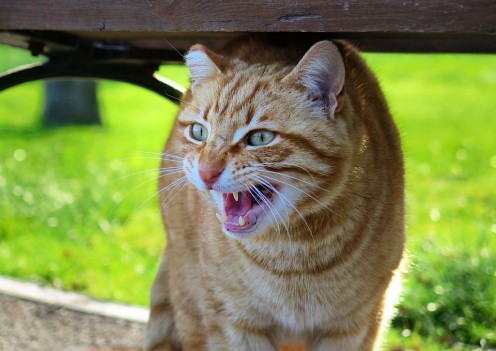
Chattering
Some cats chatter, which is a sound produced by their teeth or jaw clicking together. Of all cat vocalisations, this one is the most mysterious. It’s generally thought to convey excitement when viewing prey; "I’m about to kill something and I can’t contain my joy!" However, experts are divided on the actual purpose of the sound. Is it meant to reassure prey? Is it meant to be threatening? Is it borne out of a frustration that comes with not being able to reach the intended prey? Why do some cats do this, and not others? Your guess is as good as mine!
One theory on the purpose of the chatter is that your cat is anticipating the killing bite they’ll deliver to their prey and is reflexively moving their jaw up and down. A little disturbing, I think!
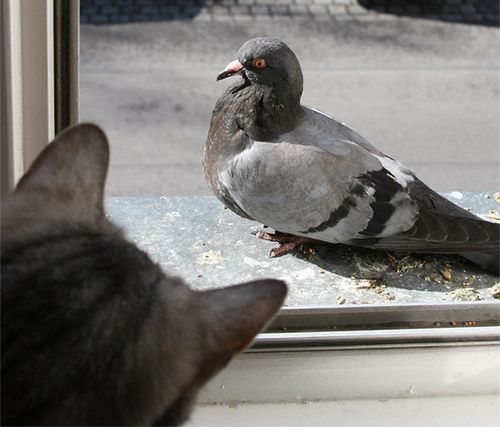
Sound
| Meaning
|
|---|---|
Purring
| "Pat me! I'm happy!"
|
Meowing
| "I want attention!"
|
Hissing
| "Back off before I claw you to death!"
|
Chattering
| "I'm excited to kill" OR "I'm annoyed because I can't reach my prey" OR "I'm warming up my jaw to strike!"
|
Disclaimer
Every feline friend is different. Cats, like humans, can use varying sounds to convey the same feelings. As such, there is no one completely accurate way to translate their vocalisations and all meanings presented in this hub are generalisations, or rather hints to what you cat is most likely trying to tell you with their various meows and hisses. The best way to truly understand your pet is to combine this knowledge with observations of their general behaviour and their body language (see my hub on translating your cat’s body language for more information!)
Were you paying attention? Take this quiz to find out!
view quiz statistics© 2017 K S Lane








